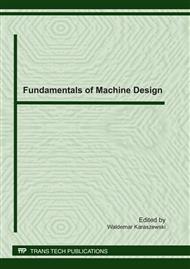[1]
S. Odenbach, Ferrofluids-magnetically controlled suspensions, Colloids and Surface, 2003, 217.
Google Scholar
[2]
L. Vekas, Ferrofluids and Magnetorheological Fluids, Advances in Science and Technology Vol. 54 (2008), 127.
Google Scholar
[3]
K. Raj, B. Moskowitz, R. Casciari, Advances in ferrofluid technology, Journal of Magnetism and Magnetic Materials,1995, 149.
DOI: 10.1016/0304-8853(95)00365-7
Google Scholar
[4]
A. G. Olabi, S. Grunwald, Design and application of magneto-rheological fluid, Materials and Design. 2007, 28.
DOI: 10.1016/j.matdes.2006.10.009
Google Scholar
[5]
A. Miszczak, Analysis of hydrodynamic lubrication of journal bearings, Gdynia, Foundation for the Development of the Gdynia Maritime University, 2006.
Google Scholar
[6]
P. Kuzhir, Free boundary of lubricant film in ferrofluid journal bearings, Tribology International, 4, 2008, 41.
DOI: 10.1016/j.triboint.2007.07.006
Google Scholar
[7]
M. Miwa, H. Harita, R. Kaneko, H. Ishizaki, Frequency characteristics of stiffness and damping effect of a ferrofluid bearing, Wear, 2003, 254.
DOI: 10.1016/s0043-1648(03)00312-0
Google Scholar
[8]
F. T. Barwell, Bearing systems, Oxforrd University Press, 1979.
Google Scholar
[9]
J. M. Guldbakke, J. Hesselbach, Developmnent of bearings and a damper based on magnetically controllable fluids, Journal of Physics, Volume 18, Issue 38, 2959, 2006.
DOI: 10.1088/0953-8984/18/38/s29
Google Scholar
[10]
K. Nagayaa, S.Takedaa, A. Satoa, A. Ikaia, H. Sekiguchia, N.Saitoa. Thrust bearing using a magnetic fluid lubricant under magnetic fields, Tribology International 1, 1993, vol. 26.
DOI: 10.1016/0301-679x(93)90033-w
Google Scholar
[11]
A. Farjoud, R. Cavey, M. Ahmadian, M. Craft. Magneto-rheological fluid behavior in squeeze mode, Smart Materials and Structures, 2009, 9.
DOI: 10.1088/0964-1726/18/9/095001
Google Scholar
[12]
M. T. López-López, P. Kuzhir, J. D. G. Durán, G. Bossis, Normal stresses in a shear flow of magnetorheological suspensions: viscoelastic versus Maxwell stresses, Journal of Rheology, 2011, 54.
DOI: 10.1122/1.3479043
Google Scholar
[13]
H. M. Laun, C. Gabriel, G. Schmidt, Primary and secondary normal stress differences of a magnetorheological fluid (MRF) up to magnetic flux densities of 1 T, Journal of Non-Newtonian Fluid Mechanic, 2008, 148.
DOI: 10.1016/j.jnnfm.2007.04.019
Google Scholar
[14]
J. C. Ulicny, C. A. Hayden, P. M. Hanley, D. F. Eckel, Magnetorheological fluid durability test-Organics analysis. Materials Science and Engineering, 2007, 464.
DOI: 10.1016/j.msea.2007.01.059
Google Scholar
[15]
J. C. Ulicny, M. P. Balogh, N. M. Potter,R. A. Waldo, Magnetorheological fluid durability test-Iron analysis. Materials Science and Engineering, 2007, 4443.
DOI: 10.1016/j.msea.2006.06.050
Google Scholar


